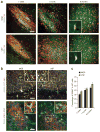Medial ganglionic eminence-like cells derived from human embryonic stem cells correct learning and memory deficits
- PMID: 23604284
- PMCID: PMC3711863
- DOI: 10.1038/nbt.2565
Medial ganglionic eminence-like cells derived from human embryonic stem cells correct learning and memory deficits
Abstract
Dysfunction of basal forebrain cholinergic neurons (BFCNs) and γ-aminobutyric acid (GABA) interneurons, derived from medial ganglionic eminence (MGE), is implicated in disorders of learning and memory. Here we present a method for differentiating human embryonic stem cells (hESCs) to a nearly uniform population of NKX2.1(+) MGE-like progenitor cells. After transplantation into the hippocampus of mice in which BFCNs and some GABA neurons in the medial septum had been destroyed by mu P75-saporin, human MGE-like progenitors, but not ventral spinal progenitors, produced BFCNs that synaptically connected with endogenous neurons, whereas both progenitors generated similar populations of GABA neurons. Mice transplanted with MGE-like but not spinal progenitors showed improvements in learning and memory deficits. These results suggest that progeny of the MGE-like progenitors, particularly BFCNs, contributed to learning and memory. Our findings support the prospect of using human stem cell-derived MGE-like progenitors in developing therapies for neurological disorders of learning and memory.
Conflict of interest statement
The authors declare no competing financial interests.
Figures






Similar articles
-
Derivation and isolation of NKX2.1-positive basal forebrain progenitors from human embryonic stem cells.Stem Cells Dev. 2013 May 15;22(10):1477-89. doi: 10.1089/scd.2012.0264. Epub 2013 Mar 5. Stem Cells Dev. 2013. PMID: 23351095 Free PMC article.
-
Medial Ganglionic Eminence Progenitors Transplanted into Hippocampus Integrate in a Functional and Subtype-Appropriate Manner.eNeuro. 2017 Apr 12;4(2):ENEURO.0359-16.2017. doi: 10.1523/ENEURO.0359-16.2017. eCollection 2017 Mar-Apr. eNeuro. 2017. PMID: 28413826 Free PMC article.
-
Directed differentiation of basal forebrain cholinergic neurons from human pluripotent stem cells.J Neurosci Methods. 2016 Jun 15;266:42-9. doi: 10.1016/j.jneumeth.2016.03.017. Epub 2016 Mar 29. J Neurosci Methods. 2016. PMID: 27036311
-
GABA-ergic cell therapy for epilepsy: Advances, limitations and challenges.Neurosci Biobehav Rev. 2016 Mar;62:35-47. doi: 10.1016/j.neubiorev.2015.12.014. Epub 2015 Dec 31. Neurosci Biobehav Rev. 2016. PMID: 26748379 Free PMC article. Review.
-
Potential of GABA-ergic cell therapy for schizophrenia, neuropathic pain, and Alzheimer's and Parkinson's diseases.Brain Res. 2016 May 1;1638(Pt A):74-87. doi: 10.1016/j.brainres.2015.09.019. Epub 2015 Sep 28. Brain Res. 2016. PMID: 26423935 Free PMC article. Review.
Cited by
-
Epigenetic regulation and factors that influence the effect of iPSCs-derived neural stem/progenitor cells (NS/PCs) in the treatment of spinal cord injury.Clin Epigenetics. 2024 Feb 21;16(1):30. doi: 10.1186/s13148-024-01639-5. Clin Epigenetics. 2024. PMID: 38383473 Free PMC article. Review.
-
Differentiation of hypothalamic-like neurons from human pluripotent stem cells.J Clin Invest. 2015 Feb;125(2):796-808. doi: 10.1172/JCI79220. Epub 2015 Jan 2. J Clin Invest. 2015. PMID: 25555215 Free PMC article.
-
Therapeutic Advances in Diabetes, Autoimmune, and Neurological Diseases.Int J Mol Sci. 2021 Mar 10;22(6):2805. doi: 10.3390/ijms22062805. Int J Mol Sci. 2021. PMID: 33802091 Free PMC article. Review.
-
Graded and pan-neural disease phenotypes of Rett Syndrome linked with dosage of functional MeCP2.Protein Cell. 2021 Aug;12(8):639-652. doi: 10.1007/s13238-020-00773-z. Epub 2020 Aug 27. Protein Cell. 2021. PMID: 32851591 Free PMC article.
-
Human forebrain endothelial cell therapy for psychiatric disorders.Mol Psychiatry. 2021 Sep;26(9):4864-4883. doi: 10.1038/s41380-020-0839-9. Epub 2020 Jul 13. Mol Psychiatry. 2021. PMID: 32661257 Free PMC article.
References
-
- Sussel L, Marin O, Kimura S, Rubenstein JL. Loss of Nkx2.1 homeobox gene function results in a ventral to dorsal molecular respecification within the basal telencephalon: evidence for a transformation of the pallidum into the striatum. Development. 1999;126:3359–3370. - PubMed
-
- Rubenstein JL, Shimamura K, Martinez S, Puelles L. Regionalization of the prosencephalic neural plate. Annu Rev Neurosci. 1998;21:445–477. - PubMed
-
- Wilson SW, Rubenstein JL. Induction and dorsoventral patterning of the telencephalon. Neuron. 2000;28:641–651. - PubMed
-
- Campbell K. Dorsal-ventral patterning in the mammalian telencephalon. Curr Opin Neurobiol. 2003;13:50–56. - PubMed
Publication types
MeSH terms
Grants and funding
LinkOut - more resources
Full Text Sources
Other Literature Sources
Medical
Research Materials

